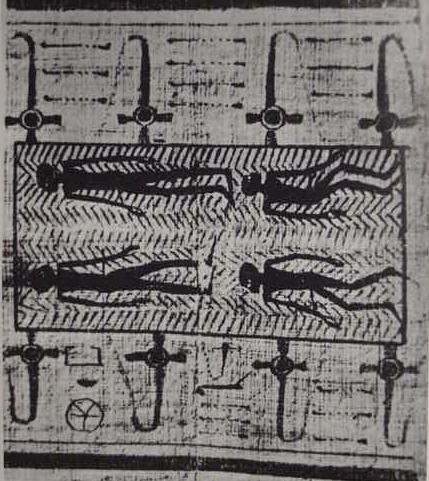The Lake of Fire and the Bodies of the Damned
18 Feb. 2004, Updates & Revisions through 09 July 2007
Please click here for this website's most important article: Why the Bible Cannot be the Word of God.
For Christians visiting this website _my most important article_ is The Reception of God's Holy Spirit:
Please click here for the article which the below picture accompanies titled Hell's Pre-Christian Origins.
Below, a photo of a Papyrus of Bakenmut, 21st Dynasty (ca. 1069-945 BCE), showing the bodies of damned floating in the Lake of Fire in the Underworld, which is fed by flames from braziers along the lake's edges.
(cf. p. 160. figure 2. Richard H. Wilkinson. Reading Egyptian Art, A Hieroglyphic Guide to Ancient Egyptian Painting and Sculpture. London. Thames & Hudson.1992)
Wilkinson on the fiery torments of the Egyptian underworld, including the lake of fire (emphasis mine):
"...fire was also an important element in the Egyptian concept of the underworld, often in ways strikingly similar to the medieval Christian conception of hell. According to the Coffin Texts and other works, the underworld contained fiery rivers and lakes as well as fire demons (identified by fire signs on their heads) which threatened the wicked. Representations of the fiery lakes of the fifth "hour" of the Amduat depict them in the form of the standard pool or lake hieroglyph but with flame-red "water" lines, and surrounded on all four sides by fire signs which not only identify the blazing nature of the lakes, but also feed them through the graphic "dripping" of their flames. In a similar manner, in the scene from the funerary Book of Gates, the damned are subjected to the fiery breath of a huge serpent, Amemet, and this and other mythological serpents are often depicted in the vignettes of Late Period papyri- bearing fire signs to identify them. However, the flames of the underworld were not necessarily to be feared by the righteous who might drink from the lake of fire and be refreshed, or change themselves into shooting flames to destroy their demonic enemies."
(p. 161. "Brazier [khet]." Richard H. Wilkinson. Reading Egyptian Art, A Hieroglyphic Guide to Ancient Egyptian Painting and Sculpture. London. Thames & Hudson.1992)
Please click here for additional pictures _in color_ showing the Egyptian underworld's Lake of Fire.
Perhaps Christianity's Book of Revelation and its notions about a "lake of fire" set aside for the damned is drawing from Egyptian notions regarding the damned's punishments? It is an established fact that Christian communities were founded in Egypt and many of today's 21st century A.D. Egyptian Christians, the Copts, trace their ancestry back to these early communities. Before their pagan Egyptian ancestors converted to Christianity they would have embraced earlier pre-christian notions of fiery lakes set aside for the punishment of the ungodly. The notion of a fiery lake set aside for the ungodly is unknown in the Old Testament, it appears however in the New Testament:
Revelation 20:10, 14 RSV
"...and the devil who had deceived them was thrown into the lake of fire and sulpher where the beast and the false prophet were, and they will be tormented day and night for ever and ever...Then Death and Hades were thrown into the lake of fire; and if any one's name was not found in the book of life, he was thrown into the lake of fire."
